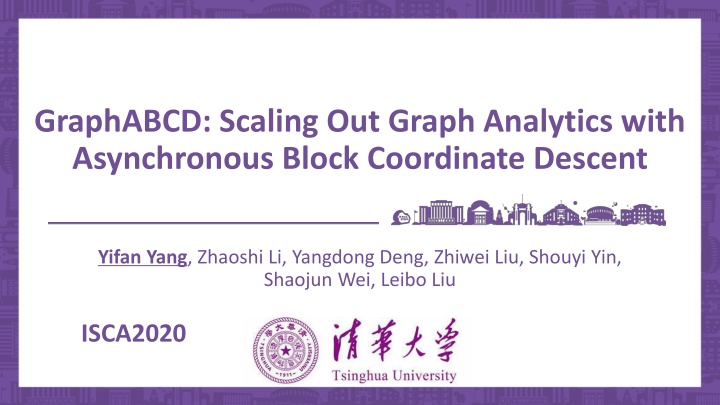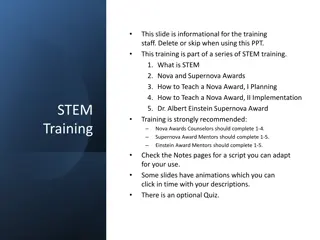Recognizing Contributions and IEEE Awards Overview
Volunteer-driven organizations like IEEE value awards to recognize and appreciate hard work, encourage continued service, inspire others to volunteer, and signify the health of the organization. Learn about the Region 3 Awards and Recognition Committee, its members, and upcoming IEEE SoutheastCon 2024.
Download Presentation

Please find below an Image/Link to download the presentation.
The content on the website is provided AS IS for your information and personal use only. It may not be sold, licensed, or shared on other websites without obtaining consent from the author.If you encounter any issues during the download, it is possible that the publisher has removed the file from their server.
You are allowed to download the files provided on this website for personal or commercial use, subject to the condition that they are used lawfully. All files are the property of their respective owners.
The content on the website is provided AS IS for your information and personal use only. It may not be sold, licensed, or shared on other websites without obtaining consent from the author.
E N D
Presentation Transcript
GraphABCD: Scaling Out Graph Analytics with Asynchronous Block Coordinate Descent Yifan Yang, Zhaoshi Li, Yangdong Deng, Zhiwei Liu, Shouyi Yin, Shaojun Wei, Leibo Liu ISCA2020
Executive Summary 2 G=(V[], E[]) while !converge(G): iteration++ for v in V[]: //do something Aim to reduce runtime of iterative graph algorithm = #_of_iterations runtime_per_iteration A 5 4 Unconverged 1 4 D Vertices B Bellman-Ford 3 3 2 Dijkstra 1 1 1 E 0 iterations 5 0 1 2 3 4 C Fewer iterations, Higher runtime per iteration
Executive Summary 3 G=(V[], E[]) while !converge(G): iteration++ for v in V[]: //do something Aim to reduce runtime of iterative graph algorithm = #_of_iterations Solution: introduce Block Coordinate Descent (BCD) execution model, an execution model for optimization algorithm, to graph analytics runtime_per_iteration BCD theory reduces #_of_iterations BCD enables efficient asynchronous processing by minimizing synchronization overhead to reduce runtime_per_iteration Evaluation demonstrates geo-mean speedup of 2.0x
Outline 4 Motivation Block Coordinate Descent (BCD) Execution Model GraphABCD System Evaluation Conclusion
Accelerating graph analytics is vital 5 Various application domains Social network analysis Navigation Fraud detection runtime = #_of_iterations runtime_per_iteration
Improving convergence rate can effectively reduce execution time 6 A 5 Unconverged 4 4 Bellman-Ford 1 Vertices D 3 B 2 3 Dijkstra 1 1 1 E 0 iterations 5 0 1 2 3 4 C Fewer iterations, higher convergence rate Prior system improves convergence rate in a case-by-case manner GraphLab, PowerGraph, Galois, Wonderland Motivation 1: A systematic approach to analyzing and optimizing the convergence rate of iterative graph algorithms is imperative
Asynchronous execution can improve runtime per iteration 7 Prior work exploits hardware acceleration to improve per iteration performance Gunrock (GPU), Foregraph (FPGA), Graphicionado (ASIC) Limited performance due to frequent synchronization Motivation 2: Algorithm and architectural support for asynchronicity are imperative for improving per iteration performance Asynchronous execution enables graph analytics to efficiently scale out to heterogeneous system
Our solution: introduce Block Coordinate Descent (BCD) execution model to graph analytics 8 Problem Domain Optimization Graph Analytics PageRank Linear Regression Deep Learning Algorithm SSSP CF BSP Execution Model SGD BCD BCD Galois-like Hardware CPU FPGA ASIC CPU FPGA ASIC GPU GPU
Our solution: introduce Block Coordinate Descent (BCD) execution model to graph analytics 9 Problem Domain Configuring BCD design parameters reduces #_of_iterations Graph Analytics PageRank Algorithm SSSP CF BSP Execution Model BCD BCD supports asynchronous processing by minimizing synchronization overhead to reduce runtime_per_iteration Galois-like Hardware CPU FPGA ASIC GPU
Outline 10 Motivation Block Coordinate Descent (BCD) Execution Model GraphABCD System Evaluation Conclusion
Outline 11 Problem Domain Optimization Graph Analytics PageRank Linear Regression Deep Learning Algorithm SSSP CF BSP Execution Model SGD BCD BCD Galois-like Hardware CPU FPGA ASIC CPU FPGA ASIC GPU GPU
Block Coordinate Descent (BCD) is an execution model for optimization algorithm 12 Optimization algorithm Aim to find vector x to minimize objective function F(x) BCD execution model updates vector x one block at a time iteratively until convergence Slice vector x into multiple blocks On every iteration, choose a specific block xn-2,xn-1,xn] =[x1,x2,x3, ,xn-2,xn-1,xn] , , =[x1,x2,x3 x x x n-2,x n-1,x n] Apply updates to the block
Porting BCD execution model to graph analytics 13 Vector x -> vertex value array v =[x1,x2,x3 x , , x n-2,x n-1,x n]
Porting BCD execution model to graph analytics 14 Vector x -> vertex value array v Example SSSP objective function: =[v1,v2,v3 v , , v n-2,v n-1,v n]
Porting BCD execution model to graph analytics 15 Vector x -> vertex value array v BCD execution: Until Convergence Choose Block Update Block Partition Graph Vertex values Adjacency matrix Processor Graph
Mapping iterative graph algorithm to BCD execution model 16 Until Convergence Partition Graph Choose Block Update Block G=(V[], E[]) while !converge(G): b=choose_block(G) for v in b: tmp_depth=MAX for ngh in v.ngh: tmp_depth=min(tmp_depth, ngh.depth+distance(v,ngh)) v.depth=tmp_depth
Design parameters of BCD execution model17 Until Convergence Partition Graph Choose Block Update Block Block Selection Method Block Update Method Block Size 1 |V| Cyclic Gradient Newton Priority
Using BCD to achieve high convergence rate 18 Insight 1: The combination of block size 1, priority block selection and gradient update allows the fastest convergence of graph algorithms. Allows us to configure BCD execution model parameters to achieve higher convergence rate
Async BCD improves runtime per iteration 19 Insight 2: BCD model can relax the requirements of synchronization of the system by implementing Asynchronous BCD model, whose convergence rate stays the same Allows us to exploit heterogeneous platform to further improve runtime per iteration We design GraphABCD, a heterogeneous Graph analytic framework with Asynchronous Block Coordinate Descent execution model
Outline 20 Motivation Block Coordinate Descent (BCD) Execution Model GraphABCD System Evaluation Conclusion
GraphABCD overview 21 We design GraphABCD, an Asynchronous graph analytic framework on CPU+Accelerator heterogeneous system GraphABCD adopts BCD execution model jointly optimizes convergence rate and runtime per iteration Selects suitable BCD design parameters to improve convergence rate Scales out graph analytics asynchronously to heterogeneity to optimize runtime per iteration
GraphABCD improves convergence rate 22 Tradeoff BCD design parameters for better hardware efficiency while maintaining high convergence rate Use slightly larger block size for better utilizing bandwidth [1] Approximate theoretical priority block selection for hardware efficiency [1] Choi, Young-kyu, et al. "A quantitative analysis on microarchitectures of modern CPU- FPGA platforms." Proceedings of the 53rd Annual Design Automation Conference. 2016.
GraphABCD scales out asynchronous BCD to heterogeneity to optimize runtime per iteration23 Until Convergence Update Partition Graph Choose Block Gather Apply Block Split
Materialize asynchronous BCD into hw 24 Until Convergence Partition Graph Choose Block Scatter Gather Apply 012345 Partitioned blocks
Materialize asynchronous BCD into hw 25 Until Convergence Partition Graph Choose Block Control Intensive Scatter Gather Apply Compute Intensive Sequential Access Compute Intensive Sequential Access Random Access
Materialize asynchronous BCD into hw 26 Until Convergence CPU Partition Graph Choose Block Scatter Gather Apply Accelerator PE
Hybrid execution scales the same computation kernel to heterogeneous resources27 Until Convergence CPU Partition Graph Choose Block Scatter Gather Available CPU Apply Gather Apply Accelerator PE
Outline 28 Motivation Block Coordinate Descent (BCD) Execution Model GraphABCD System Evaluation Conclusion
Experimental setup 29 Intel HARPv2 CPU+FPGA system FPGA frequency 200MHz Graph applications PageRank (PR), Single Source Shortest Path (SSSP), Collaborative Filtering (CF) 7 real world graphs
Convergence rate improvement up to 5x 30 Smaller block size converges faster Priority block selection improves convergence rate
Comparison with GraphMat and Graphicionado 31 Geo-mean speedup of 2.0x on execution time and 4.8x on convergence rate over GraphMat GraphMat leverages smaller block size optimization in SSSP
GraphABCD speedup breakdown 32 Bulk Synchronous Parallel (BSP) execution model baseline Sync BCD model 3.2x Async BCD model w/ hybrid and priority 1.27x Async BCD model 2.2x
GraphABCD efficiently utilizes memory bandwidth All of the FPGA memory accesses are sequential GraphABCD utilizes nearly 100% of the memory bandwidth and is bottlenecked by it 33
Outline 34 Motivation Block Coordinate Descent (BCD) Execution Model GraphABCD System Evaluation Conclusion
Conclusions 35 Jointly optimizing number of iterations and runtime per iteration is vital for high performance graph analytics BCD reduces number of iterations by tuning its design parameters and reduces runtime per iteration by asynchronous processing GraphABCD framework adopts the Asynchronous Block Coordinate Decent execution model and efficiently scales out graph analytics to heterogeneous platform Future direction: leveraging more BCD propertied to optimize graph analytics























